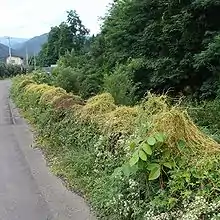Cuscuta japonica
Cuscuta japonica, commonly known as Japanese dodder, is a parasitic vine. It has been listed by the State of California as a noxious weed.[3] It has a range of effects on its host[4] and has repeatedly been introduced to the United States of America.[5] C. japonica looks very similar to other vines, making it difficult to distinguish.[6]
| Cuscuta japonica | |
|---|---|
 | |
| Scientific classification | |
| Kingdom: | Plantae |
| Clade: | Tracheophytes |
| Clade: | Angiosperms |
| Clade: | Eudicots |
| Clade: | Asterids |
| Order: | Solanales |
| Family: | Convolvulaceae |
| Genus: | Cuscuta |
| Species: | C. japonica |
| Binomial name | |
| Cuscuta japonica | |
| Synonyms | |
|
Monogynella japonica (Choisy) Hadac & Chrtek | |
Effects on host
The Japanese dodder is a plant that parasitizes other plants. From mild development issues to serious complications sometimes resulting in death, the Japanese dodder can cause a wide spectrum of effects on its plant host.[4] Farmers in particular can be affected by this plant, as infection leads to less crops they are able to harvest.[7]
Morphology
Cuscuta japonica shares a similar morphology to vines, displaying stems that are mostly yellow with bits of red along it.[6] The Japanese dodder also exhibits small flowers that are "pale-yellow to cream"[8] in color and contain one circular stigma.[9] Any leaves it has are very small and "scale-like" in shape and texture.[10] Fruit produced are small and capsule-like, only carrying a couple of seeds.[11]
History
Cuscuta japonica can be found non-invasively in a variety of places on the continent of Asia.[11] The plant was introduced and reintroduced to the United States of America multiple times starting from the 1940s under the guise of a medicinal plant, and was thought to have been eradicated a couple of times.[5]
References
- "Cuscuta japonica Choisy". Plants of the World Online. The Trustees of the Royal Botanic Gardens, Kew. n.d. Retrieved December 18, 2022.
- "Cuscuta japonica Choisy". Catalogue of Life. Species 2000. n.d. Retrieved December 18, 2022.
- "Noxious Weed Information Project: Japanese Dodder". California Department of Food and Agriculture. Archived from the original on 2010-11-22. Retrieved 2021-05-18.
- Dara, Surendra (2011-09-01). "Japanese dodder, an exotic and noxious weed found in Santa Barbara County". University of California Agriculture and Natural Resources. Retrieved 2020-03-01.
- "Cuscuta japonica (Japanese dodder)". www.cabi.org. Retrieved 2020-03-02.
- Dara, Surendra (2011-09-01). "Japanese dodder, an exotic and noxious weed found in Santa Barbara County". University of California Agriculture and Natural Resources. Retrieved 2020-03-01.
- Kaiser, Bettina; Vogg, Gerd; Fürst, Ursula B.; Albert, Markus (2015-02-04). "Parasitic plants of the genus Cuscuta and their interaction with susceptible and resistant host plants". Frontiers in Plant Science. 6: 45. doi:10.3389/fpls.2015.00045. ISSN 1664-462X. PMC 4316696. PMID 25699071.
- "Dodder". University of California Agriculture and Natural Resources. March 2010. Archived from the original on 2016-07-08. Retrieved 2020-03-01.
- Park, Inkyu; Song, Jun-Ho; Yang, Sungyu; Kim, Wook Jin; Choi, Goya; Moon, Byeong Cheol (2019-06-03). "Cuscuta Species Identification Based on the Morphology of Reproductive Organs and Complete Chloroplast Genome Sequences". International Journal of Molecular Sciences. 20 (11): 2726. doi:10.3390/ijms20112726. ISSN 1422-0067. PMC 6600609. PMID 31163646.
- Dara, Surendra (2011-09-01). "Japanese dodder, an exotic and noxious weed found in Santa Barbara County". University of California Agriculture and Natural Resources. Retrieved 2020-03-01.
- "Japanese dodder, Cuscuta japonica Solanales: Cuscutaceae". www.invasive.org. Retrieved 2020-03-02.